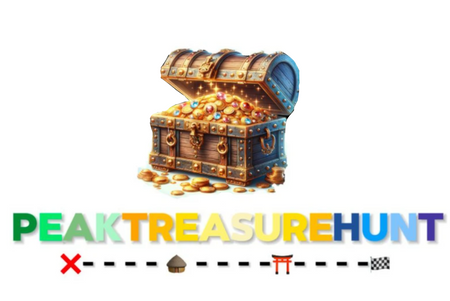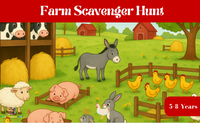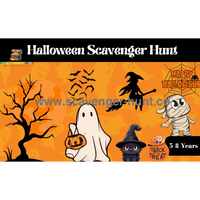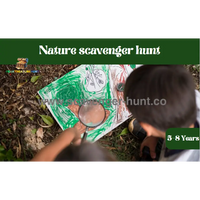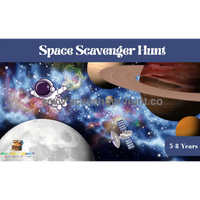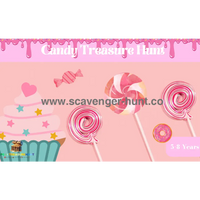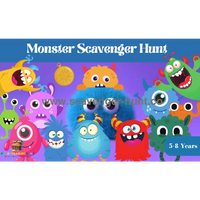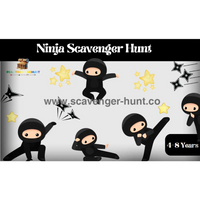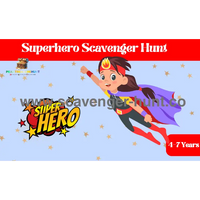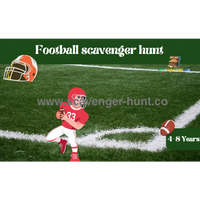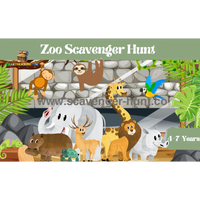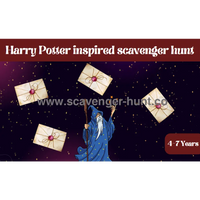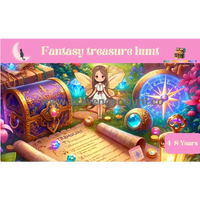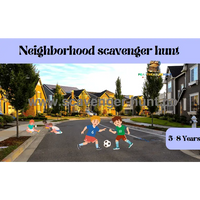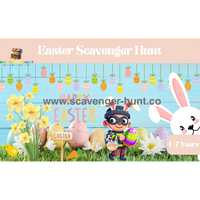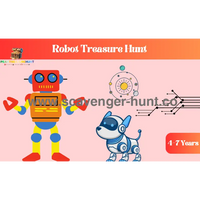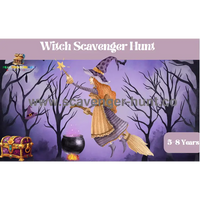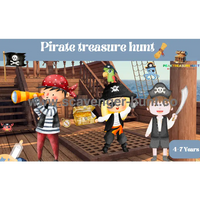🎉Indoor Adventure: The Ultimate Guide to Home Treasure Hunts
Hi! As a long-time Grundschule teacher from Hamburg and father of two adventure-loving kids, I've mastered the art of creating exciting indoor treasure hunts. When the famous German rain keeps us inside or during the cold winter months, transforming your home into a treasure-seeking paradise can turn a boring day into an unforgettable adventure. Whether you live in a cozy Stadtswohnung or spacious Einfamilienhaus, this guide will help you create magical indoor hunts that will delight children aged 4-12, while keeping them safe and engaged.
Planning Your Indoor Treasure Hunt
Every successful indoor treasure hunt needs careful preparation. Here's your essential checklist:
- Age-appropriate clues (Bildkarten for little ones, written riddles for older kids)
- Safe hiding spots away from breakable items
- Small prizes (think Überraschungstüten or educational rewards)
- Timer or stopwatch for added excitement
Pro-Tip: From my experience, 20-30 minutes is ideal for younger kids, while older ones can enjoy up to an hour of hunting.
Planning an indoor treasure hunt can be a fantastic way to engage children’s imaginations and keep them entertained, especially on rainy days or during colder months. With a little creativity and preparation, you can turn your home into an exciting adventure zone! In this chapter, we’ll guide you through the steps to plan a memorable indoor treasure hunt that will have the kids buzzing with excitement. Let’s get started! 🎉
1. Choose a Theme 🎭✨
Choosing a theme is the first step to setting the tone for your treasure hunt. A captivating theme not only makes it fun but also helps guide your planning. Here are some popular ideas:
-
Pirate Adventure: Ahoy, mateys! Transform your home into a pirate ship and have the kids search for buried treasure. You can use pirate flags, eye patches, and maps to enhance the theme. 🏴☠️
-
Fairy Tale Quest: Turn your space into a magical kingdom where kids embark on a quest to find a lost princess or enchanted objects. Use fairy lights and whimsical decorations to create a mystical atmosphere. 🧚♀️
-
Detective Mystery: Set the stage for a thrilling detective story where kids must solve clues to catch a sneaky thief or find a missing item. Use magnifying glasses and notepads for an authentic detective experience. 🕵️♂️
-
Space Adventure: Blast off into space! Kids can be astronauts on a mission to recover lost items from different planets. You can use glow-in-the-dark stars and planets to decorate the area. 🌌🚀
2. Plan Your Clues 🕵️♀️🔍
Crafting clever clues is what makes the treasure hunt exciting! Here are some tips on how to create engaging clues:
-
Rhyme and Rhythm: Rhyming clues add an element of fun. For example:
“To find your next clue, look where you sleep,
Under your pillow, it’s hidden deep!” 🛏️✨
-
Puzzles and Riddles: Incorporate simple puzzles or riddles that kids need to solve to find the next clue. For instance:
“I have keys but open no locks,
I have space but no room,
You can enter but can’t go outside.
What am I?” (Answer: A keyboard) 💻
-
Visual Clues: Use pictures or symbols for younger kids who may struggle with reading. A drawing of a couch can guide them to the next clue hidden there! 🛋️🎨
-
Sequential Clues: Make sure each clue leads to the next. A treasure map could help kids navigate through various rooms, enhancing their sense of adventure as they follow the trail. 🗺️
3. Design the Route 🚪➡️
Deciding on the route is crucial for keeping the excitement alive! Here’s how to plan an effective route:
-
Safety First: Ensure that the areas are safe and free from hazards. Remove any breakable items or obstacles that could pose a risk to the kids. 🛑
-
Room Variety: Use multiple rooms to keep things interesting. For example, you might start in the living room, then move to the kitchen, and end in the playroom. This not only makes the hunt longer but also more engaging! 🏡
-
Hidden Spaces: Think about clever hiding spots, like behind cushions, under tables, or in closets. Just make sure they are accessible and safe for the kids to reach. 🔦🛋️
-
Time Limit: Consider setting a time limit for the hunt to increase the excitement! A friendly race against the clock can motivate kids to work together and think creatively. ⏳🏃♀️
4. Gather Supplies 🎒📦
Having the right supplies will make your indoor treasure hunt run smoothly. Here’s a checklist to help you prepare:
-
Clue Cards: Write down your clues on colorful cards. This adds a vibrant touch and helps kids easily identify each clue. 🌈
-
Treasure Chest: Decorate a box or chest to serve as the treasure trove. Fill it with goodies like candies, small toys, or themed party favors. You can also add certificates for each child as a “Treasure Hunter” award! 🎁🏅
-
Decorations: Enhance the atmosphere with decorations that match your theme. Streamers, balloons, and themed props can turn an ordinary room into an exciting adventure zone! 🎈✨
-
Props for Challenges: If you’re including physical challenges, gather any necessary props (like bean bags for tossing or hula hoops). This will make the hunt more interactive! 🏅🤹♂️
5. Recruit Helpers 🙌👥
Having a few extra hands can make the event more enjoyable for everyone. Here are some ways to involve others:
-
Co-Host: Invite a friend or family member to co-host the event. They can help set up the clues, manage the treasure chest, or guide the kids through the hunt. This makes it more fun for you and the children! 🤗
-
Older Kids: If you have older siblings or cousins, consider having them assist. They can play the role of characters in your theme, such as pirates or detectives, adding an extra layer of fun! 🦜
-
Adult Supervision: Ensure there’s enough adult supervision, especially if the hunt covers multiple rooms. This keeps everyone safe and helps maintain the excitement. 🙋♀️
6. Enjoy the Adventure! 🎊🥳
Finally, the most important part is to have fun! Here are some tips to ensure everyone enjoys the day:
-
Kick-off Celebration: Start the treasure hunt with a small celebration. Gather everyone together, explain the rules, and get them pumped for the adventure! 🎉
-
Encourage Teamwork: Remind kids that the goal is to work together. Encourage them to share ideas and solve clues as a team. This fosters friendship and cooperation! 🤝
-
Capture the Moments: Don’t forget to take pictures throughout the hunt! Capture those excited faces and the fun moments to look back on later. 📸💖
Conclusion: Treasure Awaits! 🌟🏴☠️
Planning an indoor treasure hunt is an exciting way to create lasting memories and spark children’s imaginations. With a captivating theme, clever clues, and engaging challenges, you can transform your home into an adventure zone. So gather your supplies, set the stage, and get ready for a day full of laughter, teamwork, and, of course, treasure! Happy hunting! 🗝️🗺️✨
Creating Clever Indoor Clues
Make your indoor hunt engaging with these proven clue ideas:
- Household item riddles ("Where do dirty clothes go to sleep?")
- Mathematical clues ("Count 5 steps from the Kühlschrank")
- Picture-based hints for non-readers
- QR codes for tech-savvy kids (very popular in German households!)
Remember: Use familiar objects and rooms that children interact with daily.
Crafting clever clues is one of the most exciting parts of planning an indoor treasure hunt. The clues not only guide the children from one location to the next, but they also add an element of mystery and adventure to the experience. Here’s how to create engaging, fun, and challenging clues that will keep your young treasure hunters on their toes! Let’s dive into the art of clue creation! 🎉✨
1. Think About Your Audience 🎯👦👧
Before you start crafting clues, it’s essential to consider the age group of the children participating in the treasure hunt. Clues for younger children (ages 4-6) should be simple and straightforward, while clues for older kids (ages 7-12) can be more complex and require some problem-solving skills. Tailoring your clues to their level ensures everyone can enjoy the hunt!
Tip: You might even want to include a mix of easier and trickier clues to keep all the kids engaged.
2. Use Riddles and Puzzles 🧠🔍
Riddles and puzzles are a fantastic way to challenge the kids while also making the treasure hunt more entertaining. Here are a few ideas:
-
Simple Riddles: Use fun, simple riddles that lead to common household items. For example: “I have four legs, but I don’t walk,
I hold your books, and I’m a great spot to talk.
What am I?” (Answer: A table) 📚🪑
-
Word Scrambles: Create a scrambled word that they have to unscramble to find the next clue. For instance, if the clue is “Sofa,” you might write “Oafs” and let them figure it out. 🛋️🌀
-
Math Problems: For older kids, you can incorporate math problems. For example: “Add 2 + 2, then find the number of the room with that many windows.” (If they solve it right, they might need to check a room with 4 windows.) ➕➕
3. Incorporate Visual Clues 📸🔎
Sometimes, a picture is worth a thousand words! Visual clues can be especially effective for younger children who might not read yet. Here’s how to do it:
-
Picture Clues: Use images of items or rooms. For example, if the next clue is hidden under a bed, show a picture of a bed. The kids will love the challenge of matching the clue to its location! 🛏️🖼️
-
Symbolic Clues: You could use symbols instead of words. A drawing of a sun could lead them to a window, while a tree could point them to a potted plant or outside. 🌞🌳
4. Create Thematic Clues 🎭🌌
Align your clues with the theme of the treasure hunt! If you’ve chosen a pirate theme, for instance, you can use pirate lingo and terms. Here are some ideas:
-
Pirate Lingo: “To find yer next clue, go where the water flows,
Under the sink, where the treasure goes!” (Clue hidden under the kitchen sink) 🏴☠️💧
-
Fairy Tale Magic: “Where the tallest tales are told,
Search the place that’s filled with gold!” (Clue hidden in a bookcase) 📚✨
5. Use Puns and Wordplay 🥳🤪
Kids love humor, and incorporating puns and wordplay into your clues can make the hunt even more enjoyable. Here are a couple of examples:
-
Playful Puns: “I’m not a bird, but I can fly,
You’ll find your next clue where I like to lie.” (Clue hidden in a pillow) 🛏️🕊️
-
Funny Sayings: “I keep things cool and out of sight,
Your clue is hiding where it’s just right.” (Clue hidden in the fridge) 🥤❄️
6. Use Hidden Messages and Codes 📜🔒
Adding an element of secrecy can be thrilling for the kids. Here’s how to incorporate hidden messages or codes:
-
Invisible Ink: Write clues in invisible ink (lemon juice works well) that can only be seen when heated gently (with adult supervision). This adds an element of mystery and excitement! 🔥🕵️♂️
-
Simple Ciphers: Teach the kids a simple substitution code (like A=1, B=2) and let them decode the next clue. For example: “3-15-13-16-21-20-5-18” (which translates to “computer”). 💻🔑
7. Test Your Clues 🔄✏️
Once you’ve created your clues, it’s essential to test them! Walk through the treasure hunt as if you were a child:
-
Solve Each Clue: Make sure that each clue leads to the next location and that they are solvable. This will help you catch any tricky wording or logical errors. 🧩✍️
-
Time Your Route: Walk through the entire route to ensure it flows smoothly and fits within the time you’ve set for the hunt. If the kids get stuck, it can dampen their spirits, so make sure each clue is appropriately challenging! ⏰🏃♀️
8. Enjoy the Process! 🎊🥳
Creating clever clues is not just about the end result; it’s also about the fun you have while planning! Here are some ways to enjoy the process:
-
Get the Kids Involved: If appropriate, have the kids help create clues for each other. This adds a collaborative element and lets them be part of the creative process! 👦👧❤️
-
Have Fun with the Theme: As you craft your clues, get into the spirit of your chosen theme. You can dress up or use props that reflect the adventure! 🎭🌈
-
Celebrate the Success: When the hunt is over, celebrate the kids’ achievements, whether they found the treasure or simply enjoyed the adventure. A small prize or certificate of accomplishment can make their day! 🎖️🎉
Conclusion: Let the Adventure Begin! 🚀🌟
Creating clever indoor clues is a vital part of planning an unforgettable treasure hunt. With a bit of creativity, some thoughtful planning, and a touch of humor, you can design clues that will excite and engage your young adventurers. Remember, the ultimate goal is to create lasting memories and have a blast along the way! Now, get ready to embark on a treasure hunt that will be the talk of the town! Happy clue-making! 🗺️✨🧭
Indoor Safety and Space Management
Essential considerations for your home treasure hunt:
- Clear boundaries (which rooms are off-limits)
- Remove potential hazards
- Establish "no running" zones
- Keep valuable items secure
According to the Deutsche Gesellschaft für Kindersicherheit, structured indoor activities reduce household accidents by 65%.
When planning an indoor treasure hunt, ensuring the safety of the children involved is of utmost importance. Kids can get excited, run around, and sometimes forget to be cautious. By managing your indoor space effectively and implementing safety measures, you can create a fun yet secure environment for your treasure hunt. Let’s explore how to keep everything safe and sound while maximizing your indoor space! 🌟👦👧
1. Clear the Pathway 🚶♂️🧹
Before the treasure hunt begins, take a good look at the space where the adventure will unfold. Here are some essential steps to prepare:
-
Declutter the Area: Remove any obstacles, such as shoes, bags, or toys, that could trip the kids as they dash from clue to clue. A clear path allows for safe movement and reduces the risk of accidents. 🧼🧺
-
Check for Hazards: Look for sharp edges, loose wires, or fragile items that could pose a danger during the excitement. If you find anything potentially hazardous, either remove it or secure it in a safe place. Safety first! ⚡🔌
2. Designate Safe Zones 🏠🛑
Creating specific areas for activities can help maintain order and safety during the treasure hunt. Here’s how to set up your indoor space:
-
Create ‘Home Base’: Designate a central area where the kids can gather before the hunt starts. This could be a living room or a playroom. Use this space for instructions and where they can return after completing tasks or finding clues. 🏡📍
-
Set Boundaries: Clearly outline which rooms are part of the treasure hunt and which areas are off-limits. You can use tape or rope to create visible boundaries, ensuring kids understand where they can and cannot go. 🚫📏
3. Supervision is Key 👀👮♂️
Having adult supervision during the treasure hunt is crucial for ensuring safety. Here are some tips on how to keep an eye on things:
-
Assign Adult Helpers: If you have a larger group of kids, enlist a few adults to help supervise. They can assist with clue management and ensure that everything runs smoothly. More eyes mean more safety! 👫🔍
-
Stay Close: If possible, have adults positioned in different rooms where clues are hidden. This way, they can quickly intervene if anything goes awry. It also provides kids with a sense of security knowing that help is nearby. 👨👩👧👦💓
4. Use Safe Materials 🧩🌈
When preparing clues and decorations, choose safe, kid-friendly materials. Here’s what to consider:
-
Non-toxic Supplies: If you’re using paints, glues, or any materials for crafts, make sure they are non-toxic and safe for kids. Check labels to ensure compliance with safety standards. 🌱🎨
-
Soft Decorations: If you plan to create any fun decorations, opt for soft, lightweight materials that won’t hurt anyone if they fall or get knocked over. Balloons, streamers, and plush toys are great options! 🎈🧸
5. Plan for the Unexpected 🌧️🤷♀️
Even with the best planning, things can sometimes go awry. It’s good to be prepared for any surprises! Here’s how:
-
Have a First Aid Kit Ready: Accidents happen, and it’s wise to have a first aid kit on hand. Make sure it’s stocked with band-aids, antiseptic wipes, and any necessary medications. Always be prepared! 🩹🧴
-
Create a Backup Plan: In case something doesn’t go as planned, like a child feeling unwell or losing interest, have a backup activity ready. It could be a game or a snack break that keeps the energy up and spirits high. 🍎🎉
6. Educate the Kids About Safety 📚👩🏫
Before the treasure hunt starts, take a few moments to talk to the children about safety. Here’s what to cover:
-
Set Ground Rules: Explain the importance of being careful, respecting boundaries, and listening to adult instructions. Make it fun by turning it into a mini-game! 🎮🏅
-
Practice Good Behavior: Encourage the kids to help each other, share clues, and be mindful of their surroundings. Positive reinforcement can go a long way! 🌈🤝
7. Keep the Adventure Age-Appropriate 🎈🚸
When planning your indoor treasure hunt, ensure the complexity of clues and activities matches the children's ages. Here’s how to adjust accordingly:
-
Age-Appropriate Challenges: Tailor the clues and challenges to the age group. Younger kids might enjoy simpler, more visual clues, while older kids can handle more complex riddles and puzzles. 🎯🔍
-
Safe Play Equipment: If you include any physical activities or games, make sure they are safe and appropriate for the age range. Soft balls or lightweight items are good options to avoid injury. ⚽🔄
8. End on a Positive Note 🎊✨
Once the treasure hunt is complete, celebrate the children’s achievements! Here are some ideas for closing the event:
-
Share Stories: Allow the kids to share their favorite moments from the hunt. It reinforces positive memories and encourages social interaction. 📖👧👦
-
Give Awards: Hand out small prizes or certificates to recognize the kids’ participation and accomplishments. It could be something simple like a sticker or a small toy. 🏆🎁
Conclusion: Safety is the Ultimate Treasure! 🌟🏴☠️
Planning an indoor treasure hunt is all about balancing fun and safety. By managing the space effectively, supervising the children, and preparing for unexpected situations, you can create an enjoyable adventure for everyone involved. Remember, the goal is to have fun while ensuring that the kids feel secure and excited throughout the treasure hunt! Happy hunting! 🗺️🎉✨
Educational Elements
Transform your indoor treasure hunt into a learning opportunity:
- Include simple math problems
- Add reading comprehension tasks
- Incorporate time-telling challenges
- Use bilingual clues (German-English)
Studies show that playful learning activities improve information retention by 82%!
When planning a treasure hunt, why not make it both fun and educational? Incorporating learning opportunities into the adventure can enrich the experience for children, making it a memorable event that also boosts their skills and knowledge. In this chapter, we’ll explore various ways to weave educational elements into your treasure hunt while keeping it exciting and engaging! 🎉✏️
1. Choose a Theme with Learning in Mind 🌎🎨
Selecting a theme that offers educational value is a great starting point. Here are some ideas that can inspire both fun and learning:
-
Nature Exploration: Design the treasure hunt around nature, encouraging kids to learn about local plants, animals, or ecosystems. Include clues that involve identifying leaves, spotting birds, or even understanding basic environmental concepts. 🦋🌿
-
History Adventure: Use historical themes to introduce kids to significant events, figures, or cultures. You can create clues that require them to answer questions about history or solve puzzles related to famous historical landmarks. 🏰📜
-
Science Quest: Make science the star of the show! Incorporate simple experiments or scientific principles into your clues. For instance, kids might have to learn about the water cycle to find their next clue hidden near a plant. 💧🔬
2. Incorporate Problem-Solving Challenges 🧩🤔
Encouraging critical thinking is essential, and treasure hunts are a perfect setting for it! Here are some ways to add problem-solving challenges:
-
Riddles and Puzzles: Create clues that require children to think critically. Riddles, crossword puzzles, or logic problems can lead them to the next location. Not only are they engaging, but they also develop reasoning skills! 🔑🧠
-
Math Challenges: Integrate math problems into your clues. For example, a clue could read, "To find your next hint, add the number of windows in this room to the number of chairs. The answer will lead you to your next destination!" 🧮➕
3. Encourage Teamwork and Collaboration 🤝🏆
Treasure hunts are a fantastic way to foster teamwork among children. Here’s how to encourage collaboration:
-
Group Clue Solving: Create clues that can only be solved by working together. For instance, you might provide one group with half of a puzzle and another group with the other half. They’ll need to communicate and cooperate to complete the challenge. 🧩🔗
-
Team Roles: Assign specific roles to each team member, such as the clue reader, the map holder, and the communicator. This not only helps kids learn how to work together but also builds their confidence in contributing to a team effort. 🎤📌
4. Use the Environment as a Learning Tool 🌳📏
Your treasure hunt environment is a rich source of educational material. Here’s how to leverage it:
-
Interactive Learning Stations: Set up different stations where kids can learn about various topics. For example, at one station, they could learn about the solar system while searching for a clue hidden in a box labeled “planets.” 🪐📦
-
Scavenger Hunt Elements: Incorporate scavenger hunt elements that require kids to find specific items in nature or indoors. For instance, you could ask them to identify different types of leaves or colors of objects in the room. This engages their observational skills! 🍂🔎
5. Reflect and Discuss After the Hunt 🗣️🎤
After the treasure hunt concludes, take some time to reflect on the experience. Here’s how to promote learning in this final phase:
-
Group Discussion: Gather the children to discuss what they learned during the hunt. Ask them questions like, "What was your favorite clue, and why?" or "What new thing did you discover today?" This reinforces their learning while allowing them to express themselves. 🤔💭
-
Share Findings: If you included any science or nature elements, encourage kids to share interesting facts they learned. This not only reinforces their knowledge but also builds confidence in public speaking! 📢🌟
6. Make It Fun and Engaging! 🎈🌟
Learning doesn’t have to be boring! Here are some tips to keep the atmosphere light and enjoyable:
-
Use Humor: Infuse humor into your clues or challenges. Kids love to laugh, and a funny riddle or silly clue can make learning enjoyable! 😂🎉
-
Incorporate Rewards: Consider giving small rewards for educational achievements, like answering a question correctly or solving a puzzle. This adds an element of excitement and encourages them to engage fully with the educational aspects. 🥇🎁
Conclusion: Learning is the Ultimate Treasure! 💎📘
By integrating educational elements into your treasure hunt, you create a multi-faceted experience that is not only fun but also enriching. From choosing themes that spark curiosity to incorporating problem-solving challenges and encouraging teamwork, there are countless ways to make learning an integral part of your adventure. So, get creative, plan wisely, and prepare for an unforgettable treasure hunt filled with laughter and learning! Happy hunting! 🗺️✨
Making It Special
Enhance your indoor hunt with these creative touches:
- Theme-based adventures (detectives, wizards, space explorers)
- Special occasion variations (birthday hunts, holiday themes)
- Digital elements (tablet-based clues)
- Achievement certificates
Every treasure hunt should be a unique adventure that kids will remember long after it’s over. It’s the little touches that make the day feel special and create lasting memories. In this chapter, we’ll explore various ways to elevate your treasure hunt from ordinary to extraordinary. Let’s dive into the fun! 🏴☠️🌈
1. Personalize the Experience 🎁💖
One of the best ways to make a treasure hunt special is to personalize it for the birthday child or participants. Here are some ideas:
-
Customized Clues: Tailor the clues to reflect the interests of the birthday child. If they love dinosaurs, incorporate dino-themed clues or riddles. If they’re into superheroes, create clues that mention their favorite characters. This shows that you’ve put thought into the hunt and makes the experience feel more personal. 🦖🦸♂️
-
Memory Lane: Create clues or stops that relate to cherished memories shared with the birthday child. Perhaps one clue leads to a spot where they had their first birthday party or a favorite family outing. This personal touch adds an emotional element and can spark conversations about happy times. 🥳📸
2. Create a Special Atmosphere 🌟🏕️
Setting the right mood can turn a regular treasure hunt into an epic adventure! Here are some ways to create an exciting atmosphere:
-
Decorations: Use themed decorations to transform your space. Balloons, banners, and table settings can all reflect the treasure hunt theme. For a pirate-themed hunt, consider adding treasure chests and faux gold coins to the décor. These visuals will enhance the excitement and create a festive vibe. 🎈🏴☠️
-
Soundtrack: Consider playing music that fits the theme. For example, you could play adventurous instrumental music or pirate shanties to get everyone into the spirit of the hunt. Sound can greatly influence mood and excitement! 🎶⚓
3. Involve Special Guests 🎉👦👧
Having family and friends involved can elevate the experience! Think about these ideas:
-
Mystery Characters: You could invite family members or friends to dress up as characters who help or challenge the kids along the way. A friendly pirate can offer riddles, while a treasure guardian might present fun challenges. This adds an element of surprise and interaction, making the adventure more engaging. 🧙♂️👸
-
Guest Participation: Encourage family members to participate in the hunt or assist with clues. Having parents or siblings join in the fun will make the experience feel more communal and enjoyable for everyone. Plus, it’s a great way to bond! 🤗👨👩👧👦
4. Incorporate Special Rewards 🥇🎁
Kids love treasures, so think about unique prizes that will excite them! Here are some ideas:
-
Treasure Bags: Instead of one large treasure, consider providing small treasure bags at each stop. These bags could contain little toys, stickers, or candies that relate to the theme. This way, every clue feels rewarding, keeping the excitement high throughout the hunt. 🏺🍭
-
Certificates and Awards: At the end of the treasure hunt, present each child with a fun certificate or award that highlights their unique contributions or strengths during the hunt. For instance, “Best Detective” or “Top Clue Solver” adds a touch of recognition and makes them feel special. 🎖️📝
5. Capture the Moments 📸❤️
Don’t forget to document the fun! Here are some suggestions for capturing memories:
-
Photo Booth: Set up a photo booth area with props related to the theme. Kids can take silly pictures as they celebrate their achievements. Consider using a themed backdrop to make it even more special! 📷🤳
-
Treasure Hunt Scrapbook: After the event, create a scrapbook filled with photos, clues, and stories from the treasure hunt. You can ask kids to contribute their favorite memories or drawings related to the event. This can be a lovely keepsake for the birthday child to look back on! 📖✂️
6. End on a High Note 🌅🌟
Concluding the treasure hunt with a memorable finale will leave a lasting impression. Here’s how to wrap things up:
-
Treasure Reveal: Make the final treasure reveal exciting! Perhaps the last clue leads to a grand treasure chest filled with goodies, and you can create a fun unveiling moment. You could even have a special song or cheer ready to celebrate their accomplishment! 🎊🎤
-
Group Celebration: Host a mini-celebration after the treasure hunt. This could be as simple as a cake or snacks to share while recounting the day’s adventures. It’s a great way to celebrate everyone’s hard work and the fun they had together! 🍰🥳
Conclusion: The Magic of Special Moments 🌈✨
By adding personal touches, creating a vibrant atmosphere, involving special guests, and capturing memories, your treasure hunt can become a truly magical experience. The joy and excitement on the children's faces will be priceless! Remember, it’s the effort and thoughtfulness that create those unforgettable moments. So, go ahead and make your treasure hunt as special as the kids who embark on it! Happy hunting! 🗺️🎉
Frequently Asked Questions
Q: How do I keep siblings of different ages equally engaged?
A: Create parallel hunts with age-appropriate clues, or pair younger kids with older ones as "junior detectives."
Q: What are good prizes for an indoor treasure hunt?
A: Consider books, craft supplies, small toys, or special privileges (like choosing dinner). Remember our German tradition of combining learning with fun!
Q: How can I prevent children from getting too excited and running indoors?
A: Include "slow motion" zones or "tiptoeing" challenges in your clues. Make quietness part of the game.
Q: What if we live in a small apartment?
A: Focus on quality over quantity - use more complex clues and multiple steps in each location. Small spaces can hold big adventures!
Q: How often can we repeat the same treasure hunt?
A: Wait at least 3-4 weeks before repeating, and change the clues and hiding spots. Kids love familiar formats with new challenges.
Conclusion
Creating an exciting indoor treasure hunt is more about creativity than space or resources. From my years of experience organizing these hunts in German homes, I've learned that the most memorable adventures often happen in the most ordinary places. Start with simple hunts, learn what excites your children, and adapt accordingly. Remember, every indoor hunt is an opportunity to create lasting memories, especially during those long German winters or rainy days. The joy of discovery knows no bounds - even within four walls!
Discover our Complete Scavenger Hunts Collection.
